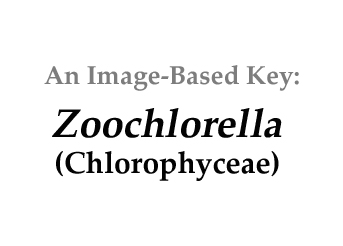|
Home / Chlorophyceae / Unicells / Non-flagellated / Zoochlorella |
||||
|
|
|
|||
|
Click
on images for larger format |
||||
Name
derivation:
|
||||
|
Zoo-
animal [protest] + chlor green _ ella diminutive refers to small green
bodies within a protest.
|
||||
Classification:
|
||||
Zoochlorella K.
Brandt 1881; 1 of 3 species descriptioins is currently
accepted taxonomically (Guiry and Guiry 2013).
Order Chlorellales; Family Chlorellaceae
|
||||
Morphology:
|
||||
|
Unicell. Vividly green. |
||||
imilar genera:
|
||||
|
|
||||
Habitat:
|
||||
|
Freshwater and marine habitats,
often found symbiotically within protozoans or invertebrates. When endobiotic they often color the host
green. Common examples are species of
ciliates, hydras, sponges and anemone. In the 1850s - 1880s the question both of origin
and relationship to the host was actively pursued. Were they capable of free living similar to Chlorella, and therefore able to be
cultured free from their host? In some
tests they were not, in others they were successfully cultured, certainly by
Loefer (1936). Were Zoochlorella
in ‘infection’ and thus a parasite, or were they ‘symbionts’ – a term defined
by DeBary (1879). Recent molecular
evidence provides convincing evidence that multiple symbiotic events or
multiple unflagellated green unicells have occurred. More than one green species can occur even
within the same host cell (Proschold
et al. 2011). Furthermore, of 17 isolates from various
hosts, endobionts belonged to eight independent species from six different
genera of green algae (Ibid.), so Zoochlorella
is not a useful generic name except for historic reasons. |
||||
References:
|
||||
|
Brandt,
K. 1881 . Über das Zusammenleben von Thieren und Algen. Verh. Physiologischer Ges. 1881-1882:
22-26. DeBary, A. 1879.
Die Erscheinung der Symbiose.
Strasburg: Verlag von Karl J. Trubner. Guiry, M.D. and G.M. Guiry 2013.
AlgaeBase.
World-wide electronic publication, National University of Ireland, Galway.
http://www.algaebase.org; searched on 15 October 2012. Loefer, J.B.
1936. Isolation and growth
characteristics of the “Zoochlorella” of Paramecium bursaria. The American Naturalist 70(727):184-188 Pröschold, T., T. Darienko, P.C. Silva, W.
Reisser and L. Krienitz 2011. The systematic of Zoochlorella revisited employing an integrative
approach. Environmental Microbiology
13(2):350-364. Secord, D. and Augustine, L. (2000), Biogeography
and microhabitat variation in temperate algal-invertebrate symbioses:
zooxanthellae and zoochlorellae in two Pacific intertidal sea anemones,
Anthopleura elegantissima and A. xanthogrammica. Invertebrate Biology, 119:
139–146. doi: 10.1111/j.1744-7410.2000.tb00002. |
||||






